I had a very close call recently while walking home from the subway. I wasn’t attacked or anything such as that, but it could have been worse. I had left work, distressing with my headphones on listening to some tunes. I was close to home, not really focusing on my surroundings, and before I knew it there was an instinct to leap out of the way.
What I was barely aware of was a car had cut into the lane of another, striking it, and both plowed towards where I was. If I hadn’t leapt, I would have been struck for sure. I had to take a minute to gain composure, both with the near collision, as well as trying to figure how I knew to leap, but strangely I was very calm in the after-math and my head was crystal clear.
I don’t remember seeing the cars coming towards me, or it happening. I had a memory of the sound. It was like my body or some part of my mind reacted before my conscious awareness even knew. It was freaky.
Sensei Steve Fogarsi speaks often to us about being aware of our surroundings when we are out. Being alert and ready for danger. However, in this instance I wasn’t taking that advice, and all I can think is that my training somehow saved me.
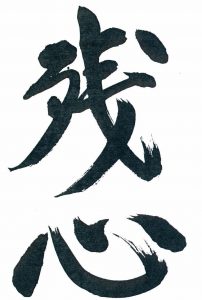 There is a term in Japanase called Zanshin. There is no real translation, but it is a state of awareness, of relaxed alertness, in Japanese martial arts. A literal translation of zanshin is “remaining mind”. It usually refers to a state of mind immediately after a fight, or when you perform a perfect technique, without even being aware that you did.
There is a term in Japanase called Zanshin. There is no real translation, but it is a state of awareness, of relaxed alertness, in Japanese martial arts. A literal translation of zanshin is “remaining mind”. It usually refers to a state of mind immediately after a fight, or when you perform a perfect technique, without even being aware that you did.
The person might feel a sudden rush of energy and strength, with every fibre of your being in full attention and focus. Either on the opponent, or as in my own personal experience, the accident that just took place.
According to the Japanese, this is an instinct we all have within us. Not requiring learning, but rather remembering. By training our bodies and mind through karate, through proper focus, kiai, and eventually even a state of mushin, as Forrest E. Morgan says, in Living The Martial Way, “we strip away the conditioning of modern civilization has put on us, impeding our access to this basic fighting instinct. Once we remove those blocks to our natural fighting skills, zanshin emerges for us to discover” ( Morgan 1992, P. 129)
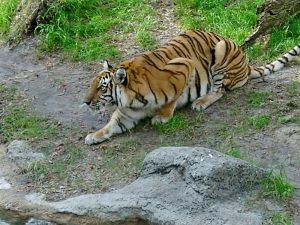 All predatory animals have this instinct. From cats to wolves, and yes… even to man. Watch a video of a tiger attacking its prey. After the attack it might posture up, look around with full attention on its prey in sheer dominance. What do you think would happen if the prey began to move again?
All predatory animals have this instinct. From cats to wolves, and yes… even to man. Watch a video of a tiger attacking its prey. After the attack it might posture up, look around with full attention on its prey in sheer dominance. What do you think would happen if the prey began to move again?
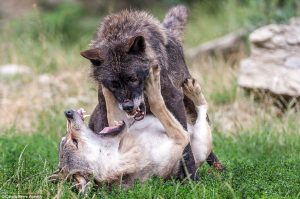 Or a wolf when it fights another wolf for alpha position. Eventually one dominates the other, pinning it to the ground on it’s back. Straddled with teeth bared, growling ready to rip open its throat, the other wolf frozen in defeat. The dominate wolf will not finish it, but rather back away with every fibre of it’s being focused on the animal before it. Still ready and triggered to fight again should the opponent even flinch. This is complete dominance. This is zanshin.
Or a wolf when it fights another wolf for alpha position. Eventually one dominates the other, pinning it to the ground on it’s back. Straddled with teeth bared, growling ready to rip open its throat, the other wolf frozen in defeat. The dominate wolf will not finish it, but rather back away with every fibre of it’s being focused on the animal before it. Still ready and triggered to fight again should the opponent even flinch. This is complete dominance. This is zanshin.
So finding your own zanshin is a process rather than learning. But it starts like Sensei Fogarasi said, being completely alert, aware of your surroundings while out and about, or complete but relaxed focus on the opponent in front of you.
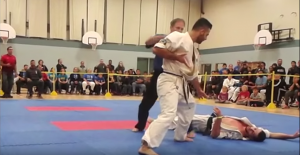
The way to develop this is to experience it, internalize it, and if you feel it, be able to draw upon it again when required. When it does happen you will instinctually recognize it, and you might already have. You’ll feel the energy within you, with the feeling or knowing that with the slightest move you can pounce. It’s a feeling you won’t forget!
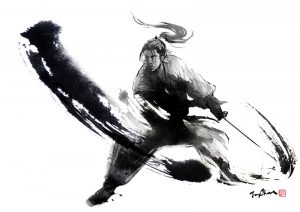 The goal, including for myself, is to enter zanshin anytime you want, or when you sense danger. Poised and focused, ready to strike, or move. The Samurai had a name for this state, “happo zanshin”, or eight-directional awareness.
The goal, including for myself, is to enter zanshin anytime you want, or when you sense danger. Poised and focused, ready to strike, or move. The Samurai had a name for this state, “happo zanshin”, or eight-directional awareness.
This isn’t some mystical experience, but rather something that is buried in our primal brains, our “Lizard Brains“, from a time long ago when we needed that awareness to survive. The ability to sense and know your enemies’ decision to attack even before he did. We would have required this to survive as a species long ago. But like many abilities we required back then, they have been forgot in modern “easier” survival times.
The Reptilian Brain. The brain stem and the first part of the brain to evolve, 100 million years ago. It holds our instinctual fears and not capable of higher thought. Then there is mammalian brain, the second part of the brain to evolve, and another storage area for fear. Inside this portion of the brain is the amygdala, the memory center for emotions and storage area for all of your painful and threatening experience of life. A warehouse for everything that is frightening to you.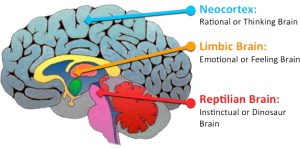
The amygdala is directly connected to the action part of your fear system, the endocrine gland. It produces hormones like adrenaline and cortisol, which help protect the body from danger and put us in survival mode. They’re also known as “fear hormones” or “stress hormones”, enabling us to run faster and fight harder, and trigger the release of excitatory neurotransmitters in the brain that makes us alert.
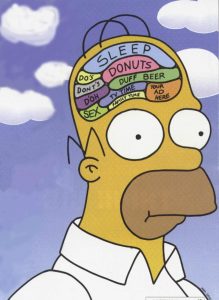 There is another part of the brain called the neocortex. The last part created of the brain created during evolution, and also the last part that is developed in the womb. This is where your intellect comes from, and where the spirit resides. Linking intellect with intuition and the subconscious. This is the part of the brain that tells the lower “Lizard Areas” areas “calm down”. Unfortunately, we sometimes fail to hear and remain caught up in all the noise and chatter, feel overwhelmed and exhausted in the moment. This the battle between the reptilian brain and the neocortex. Finding that balance is where Zanshin comes from.
There is another part of the brain called the neocortex. The last part created of the brain created during evolution, and also the last part that is developed in the womb. This is where your intellect comes from, and where the spirit resides. Linking intellect with intuition and the subconscious. This is the part of the brain that tells the lower “Lizard Areas” areas “calm down”. Unfortunately, we sometimes fail to hear and remain caught up in all the noise and chatter, feel overwhelmed and exhausted in the moment. This the battle between the reptilian brain and the neocortex. Finding that balance is where Zanshin comes from.
If we as Kyokushin Karate practitioners are training correctly, with pure focus, intent, kiai and eventually after a long time, mushin, then zanshin will only naturally follow. This can be developed faster by trying to be alert not only in your karate practice, but in all areas of your life. And then when it does happen, basking in it and deeply coding the feeling in your every fibre, to be called upon again, when needed.
OSU!
Contact Kicks‘ Amir Bahmeyeh’s Full fight from the image:
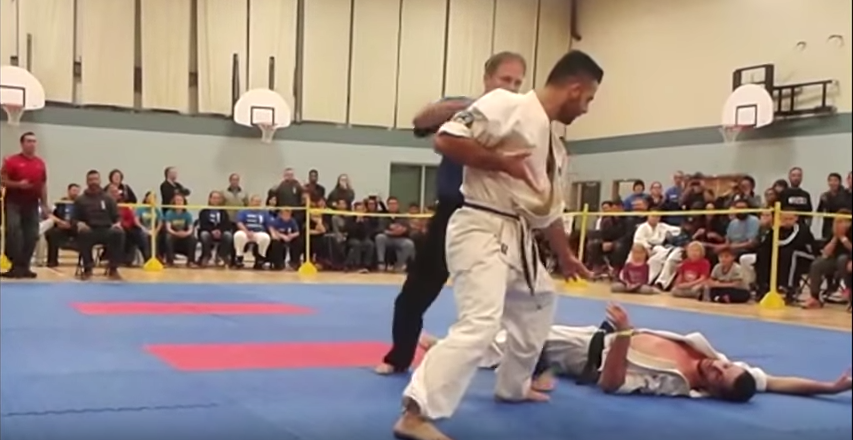
Oh, Sue … that’s close but not what all the Japanese and Chinese discussion about Shin/Shen/Kami is about.
Interesting article again Scott. You explanation is very similar to some of the new third wave approaches to understanding emotion in human suffering- some of the compassionate mind approaches, which state that. ‘Humans have evolved with at least three primal types of emotion regulation system: the threat (protection) system, the drive (resource-seeking) system, and the soothing system.’
Thanks again for an interesting article. Best wishes, Heledd
[…] Sensei Steve Fogarsi speaks often to us about being aware of our surroundings when we are out. Being alert and ready for danger. However, in this instance I wasn’t taking that advice, and all I can think is that my training somehow saved me. […]
Osu !
very good, but I do not agree that you should be walking with head phones on if you wish tp know and hear your surriunds